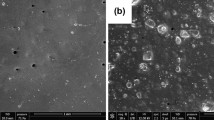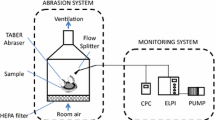Abstract
The modification of the traditional interior wall paint was carried out by means of adding nano-TiO2 as a functional pigment. By regulating the dosage of dispersant, the nano-particles can be dispersed in paint homogeneously. With two aspects of experiments: dosage of nano-TiO2 and pigment volume concentration (PVC), the paint formulation can be optimized and its properties, such as hardness, scrub resistance, storage stability, contrast ratio and gloss can be improved. Finally an interior wall paint with high performance and air purification was prepared. Its character of formaldehyde degradation would be discussed in the next article.
Similar content being viewed by others
References
Xu Guo-cai, Zhang Li-de. The Nano Composite Material [M]. Beijing: Chemical Industry Press, 2002: 298–299 (in Chinese).
Yang Yi, Wei Wei, Zhang Xue-lian. Building coating prepared with composite nano-TiO2 [J]. Chemical Materials for Construction, 2002, 18(2): 16–18 (in Chinese).
Zhang Ling-hua, Wang Xue-song, Lu Heng-rong. Application of nanotechnology in exterior architectural coating [J]. Chemical Materials for Construction, 2004, 20(3): 19–22 (in Chinese).
Din Yan-wen, Fan hong-zheng. Research on surface coating of nanoscale titania [J]. Modern Chemical Industry, 2001, 21(7): 18–22 (in Chinese).
Xu Cun-yun, Duan Yun-biao, Zhang Peng-xiang, Qin Ya-qin. Surface modification of nanometer TiO2 [J]. Yunnan Chemical Industry, 2000, 27(5): 6–7 (in Chinese).
Gao Jin-wei, Wang Jia-bang, Yang Hui. Application research on modified nano-TiO2 in acrylic interior wall latex paint [J]. Journal of the Chinese Ceramic Society, 2002, 30(21): 138–140 (in Chinese).
Tiarks F, Frchen T, Kirsch S, Leuninger J, Melan M. Formulation effects on the distribution of pigment particles in paints [J]. Progress in Organic Coating, 2003, 48(2–4): 140–152.
Patron T C. Coating Flow and Pigment Dispersion [M]. Beijing: Chemical Industry Press, 1988: 161–163 (in Chinese).
Rio G, Rudin A. Latex particle size and CPVC [J]. Progress in Organic Coating, 1996, 28(4): 259–270.
Floyd F L, Holsworth R M. CPVC as point of phase inversion in latex paints [J]. Journal of Coating Technology, 1992, 64(806): 65–68.
Author information
Authors and Affiliations
Corresponding author
Additional information
Project supported by the Foundation of National Key Technologies Research and Development Program—Shanghai World Expo Special Project (Grant No.04DZ05803)
About this article
Cite this article
Wang, Xq., Zhang, Jp., Zhu, Wd. et al. Preparation and properties of nano-TiO2 modified interior wall paint. J. of Shanghai Univ. 11, 432–436 (2007). https://doi.org/10.1007/s11741-007-0422-z
Received:
Revised:
Issue Date:
DOI: https://doi.org/10.1007/s11741-007-0422-z




